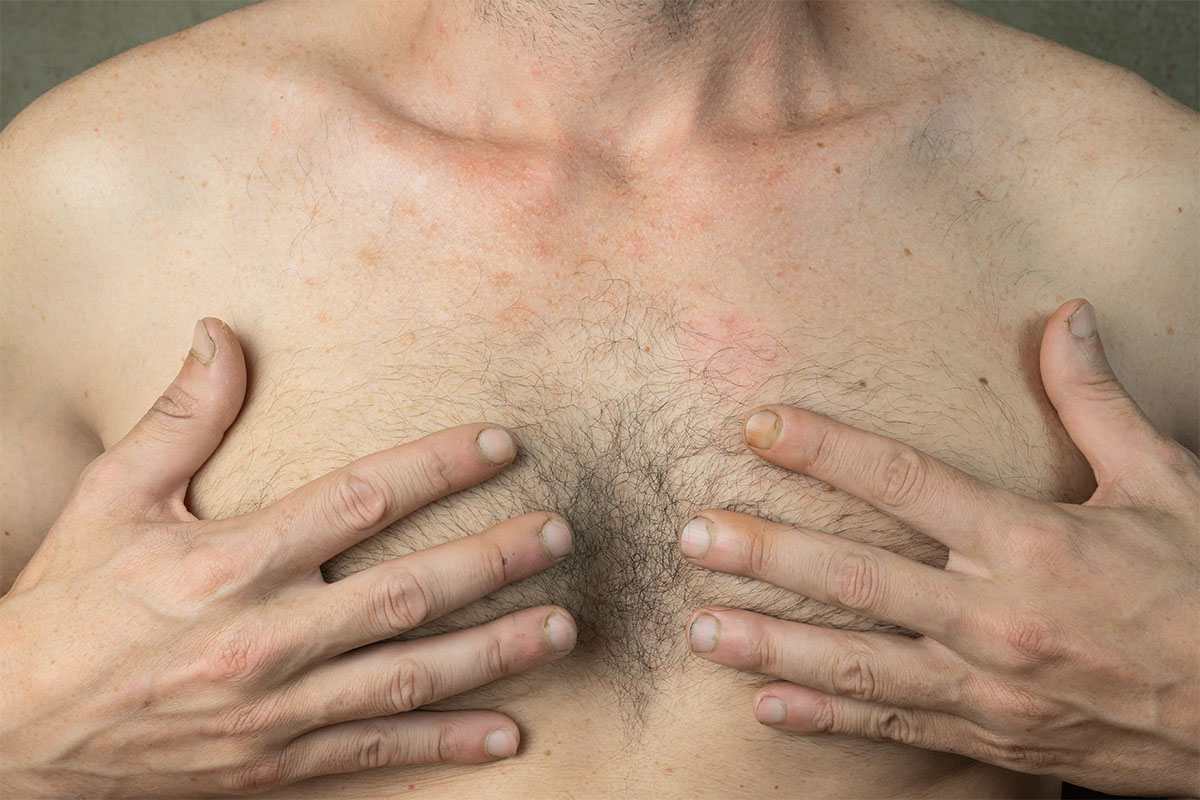
Ever wondered how gynecomastia scars can impact your self-confidence? This article extensively covers what this condition is, the surgical treatment options available, and, most importantly, how to manage and minimize scar formation. This comprehensive guide is designed to help you navigate your way to a more confident and comfortable you.
Gynecomastia and Excess Breast Tissue
Gynecomastia refers to the enlargement of breast tissue in men due to an imbalance of hormones. It’s characterized by the growth of glandular tissue, not excess fatty tissue. The removal of the excess breast tissue is vital to rectify this condition. Surgical procedures often involve removing this excess tissue, which can be a combination of glandular, fatty, and sometimes skin tissue depending on the severity of the case. After removal, patients typically experience a significant improvement in body contour and self-confidence.
The Role and Expertise of Surgeons in Gynecomastia Surgery
Notably, the surgeon’s role inherently determines the success of gynecomastia surgical procedures. A specialist plastic surgeon possesses the refined skill of making incisions in discreet areas, hence ensuring less noticeable scars. Their experience also provides them with the unique insight and understanding necessary to plan a surgical strategy that strikes a balance between achieving the desired shape and minimizing scar prevalence.
Additionally, surgeons play an essential role in guiding patients through the recovery process after gynecomastia surgery. This involves explaining what to expect and how to effectively manage discomfort, thus ensuring faster and smoother healing. Trusted plastic surgeons further invest considerable time and effort in enhancing their techniques and strategies, invariably helping improve patient outcomes over time.
Surgical Approaches for Gynecomastia: Liposuction and Surgical Excision
Choosing the right surgical approach for gynecomastia often depends on the individual patient’s needs. On one hand, liposuction is an effective method for removing excessive fat around the breasts. It is a less invasive procedure, often preferred by patients seeking minimal scarring. On the other hand, surgical excision is deployed when the removal of glandular tissue or excess skin is required. This surgery may result in better contouring but tends to involve larger incisions.
Healing Process and Scar Development After Gynecomastia Surgery
Upon completion of the gynecomastia surgery, the healing process initiates immediately. The body launches a series of intricate cellular events, aiming to rebuild the damaged tissue and skin. In the meantime, your gynecomastia surgeon may advise maintaining a slight degree of redness as it indicates an ongoing healing process.
Scar tissue forms as part of this recovery, replacing the normal skin. The severity of the scar can vary based on factors like the surgical techniques employed, individual healing abilities, and the level of post-surgery care. Thus, understanding and managing the healing process is integral to reducing scar visibility after gynecomastia surgery.
Importance of Proper Care for Healing Incisions and Minimizing Scarring
Proper care of healing incisions is vital after any surgical procedure, including gynecomastia. It ensures the surgical wound heals properly and leads to minimal scarring. Care includes maintaining proper hygiene to avoid infections that can delay the process and exacerbate scarring. Remember, diligent and careful attention to your healing incisions contributes significantly towards achieving your desired aesthetic result.
Helpful Treatments for Gynecomastia Surgery Scars
Treatments for gynecomastia surgery scars are plentiful and can help to reduce pronounced scars. Techniques such as laser therapy can help to minimize scarring and reduce visibility. Scar care products and silicone sheets are also effective. Laser treatments specifically can resurface the skin and lessen the intensity of noticeable scars.
With careful management, scars from this plastic surgery can become less visible over time. These treatment options allow patients to confidently move forward post-surgery, as the noticeable scars from the procedure become less prominent. While it requires patience and dedication, the improved aesthetic of less visible scars is often a rewarding outcome.
Do note that individual results greatly vary and consultation with a medical professional is key to finding the appropriate scar treatment regimen.


SPECIALIST CARE YOU CAN TRUST
Dr. Salloum is supported by a brilliant team of caring staff members.
You can trust the entire staff to help make your visit as comfortable and safe as possible!
The Role of Silicone Sheets and Scar Care Products
Silicone plays a crucial part in scar care post-gynecomastia surgery. Silicone sheets help in scar healing by maintaining hydration in the tissue and moderating collagen production. The consistent use of silicone-based care products can visibly improve the texture and color of your surgical scars. Thus, their use is recommended for optimal scar reduction. With good care, the negative impacts of scarring can be minimized.
Attaching Importance to Post-Surgery Lifestyle and Care
Following liposuction or any surgical or cosmetic procedure, overseeing your body’s natural healing process demands the utmost attention. In the early weeks after cosmetic surgery, your daily activities must involve ease and careful movements, ensuring the wound heals properly.
Introducing light exercise weeks after the surgery enhances this healing process. Staying active boosts circulation, reducing swelling and accelerating recovery further. However, strenuous activities must be avoided until your doctor gives the go-ahead.
Hygiene also plays a crucial role in post-surgery care. It safeguards the surgery site from infections, which could potentially slow down the recovery or lead to complications. Therefore, maintaining a clean environment and proper wound care is essential in this period.
Remember, the journey to your improved physique doesn’t end in the operation room. It extends to how well you care for your body post-surgery.
Significance of Compression Garments after Gynecomastia Surgery
Post-gynecomastia surgery, wearing a compression garment becomes pivotal. It aids in reducing swelling and improves comfort during the initial healing period. These garments, when worn, do a great job of controlling swelling, which in turn minimizes scarring.
Furthermore, these garments provide the necessary support, reduce movement, and stabilize the surgery area, accelerating recovery. The consistent pressure applied helps reshape masculine chest, enhancing overall aesthetic results. Wearing a compression garment post-surgery is thus a significant step towards achieving the desired post-gynecomastia surgery results.
Factors that Influence Scarring After Surgery for Gynecomastia
Several factors impact scarring after surgery for gynecomastia. In people who had considerable excess tissue, the size and location of surgical incisions may be different, potentially leading to larger scars. Also, each body responds differently to surgery and healing, so the appearance of scars happens at unique rates over several weeks.
An individual’s health status also plays a key role. People with certain medical conditions, such as diabetes, or those who smoke, may have a more visible scarring. It’s essential to discuss these factors with an experienced surgeon before surgery.
Individual Differences in Scar Healing and Appearance
Scar healing after chest reduction surgery will vary between people. The scar appearance can depend on factors such as skin type, genetics, and lifestyle. For instance, skin that has a high production of collagen may result in more noticeable scars. The body’s healing process can also differ, affecting the size and redness of the scar. Recognizing these individual differences can inform post-surgery care decisions.
Practical Tips to Minimize and Manage Gynecomastia Surgery Scars
To manage gynecomastia surgery scars, prioritize keeping incisions clean in the initial weeks. This helps reduce infection risks, promoting minimal scarring. Around this period, control your physical activity level to avoid stressing the area, maintaining precision in movement to curb unwanted tension on the wound.
Maintaining optimal position, especially during sleep, also helps manage the size and visibility of scars. Sunscreen application is crucial post-surgery to protect the incisions from harsh UV rays, which could worsen scarring.
Considering the effectiveness of regular exercise in improving bodily functions and blood circulation, it’s advisable to gradually reintroduce it into your routine. However, ensure it’s moderate and consult with your surgeon first.
Effectiveness of Exercise and Positioning in Scar Management
Proper exercise and position during the healing process, post gynecomastia surgery, can significantly aid in minimal scarring. By controlling the position of the body, people undergoing the healing process can reduce unnecessary stress on the surgical area. Gentle exercise facilitates blood flow, speeding up the healing and reducing scarring. However, people must follow their medical professionals’ exercise and positioning recommendations. A rushed or improper technique can hamper the process. With the right approach, patients can experience beneficial results on their journey to recovery.
Why Keep Incisions Clean and Sun Protected?
Proper hygiene plays an indispensable role in the healing of the incision sites, post gynecomastia surgery. The patient must keep incisions clean to prevent infections and promote swift recovery. Sunlight can potentially lead to hyperpigmentation around the incision site, making scars more pronounced. Therefore, both patients and plastic surgeons must pay paramount attention to sun protection for incision sites. Being diligent about incision care post-surgery could significantly aid in minimizing scarring and ensuring smoother healing.
Remember: managing gynecomastia surgery scars requires expert advice. It’s not just about what you do; it’s also how and when you do it. Make an informed decision. Consult with board-certified plastic surgeon Dr. Gabe Salloum. Drawing from his extensive experience, Dr. Salloum can provide insightful advice and personalized solutions to ensure optimal healing and minimal scarring.